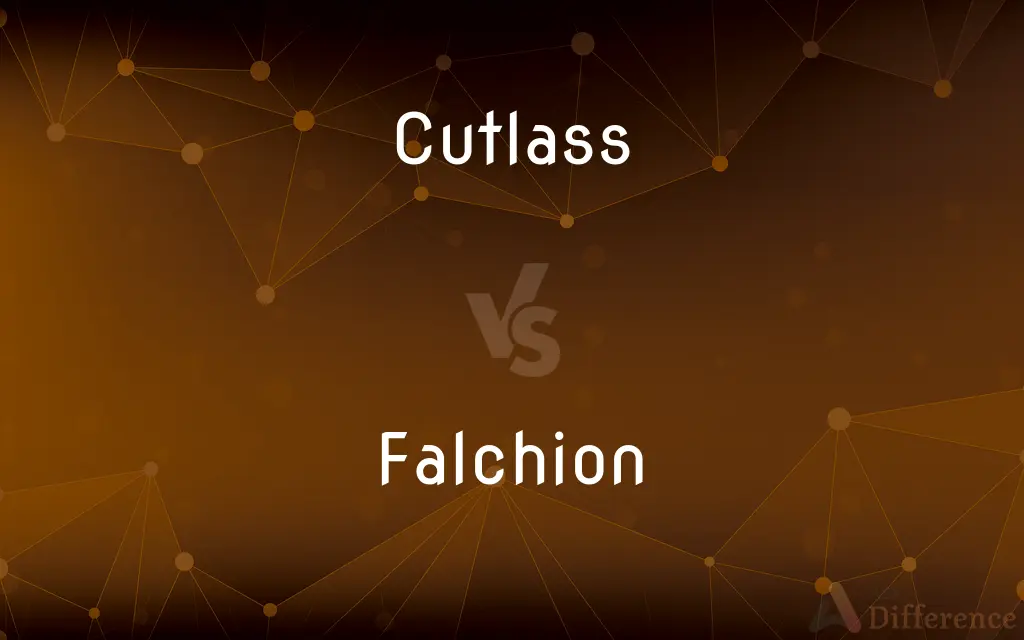Cutlass vs. Falchion — What's the Difference?
Edited by Tayyaba Rehman — By Fiza Rafique — Updated on April 9, 2024
A cutlass is short, broad saber with slightly curved blade, associated with naval warfare and piracy, while falchion is one-handed, single-edged sword of European origin, with curved blade that tapers to a point, used from the 13th to the 16th centuries.

Difference Between Cutlass and Falchion
Table of Contents
ADVERTISEMENT
Key Differences
The cutlass, with its short and broad design, was ideally suited for the close quarters of naval battles and piracy. Its slightly curved blade was effective for slashing during boarding actions on ships. The falchion, on the other hand, was a medieval European sword designed more for land-based combat, with a blade that combined the weight and power of an axe with the versatility of a sword.
Cutlasses are typically associated with sailors and pirates from the 16th to the 19th centuries, embodying the spirit of naval warfare and maritime adventure. Falchions were used by a variety of European warriors, including knights and infantrymen, reflecting a broader application in historical land battles and duels.
The design of the cutlass emphasizes ease of use in tight spaces, such as the decks of ships, making it a practical weapon for naval personnel. In contrast, the falchion's design, with its broader and heavier blade towards the tip, allowed for powerful cuts, making it effective both on horseback and on foot in open combat.
Despite their differences, both weapons are single-edged and designed primarily for slashing, showcasing the adaptability of sword design to specific combat situations and environments. The cutlass, with its compact size, and the falchion, with its unique blade shape, each served their users' needs based on the combat scenarios they were likely to face.
Comparison Chart
Origin
16th to 19th century, Naval
13th to 16th century, European
ADVERTISEMENT
Design
Short, broad, slightly curved blade
One-handed, single-edged, curved blade to a point
Usage
Naval warfare, piracy
Land combat, including duels and battles
Association
Sailors, pirates
Knights, infantrymen
Blade Feature
Broad for slashing in close quarters
Tapers to a point, heavier towards the tip for powerful cuts
Compare with Definitions
Cutlass
A short saber used by sailors and pirates.
The cutlass was a pirate's weapon of choice.
Falchion
Used from the 13th to the 16th centuries.
The falchion was popular among medieval European warriors.
Cutlass
Designed for close combat on ships.
The cutlass's design made it ideal for boarding actions.
Falchion
Combines the power of an axe with sword versatility.
Falchions were designed to deliver powerful slashes.
Cutlass
Suited for tight spaces found on ships.
Sailors favored the cutlass for its ease of use in confined areas.
Falchion
Suited for battles and duels on land.
Knights and infantrymen commonly used the falchion.
Cutlass
Essential for naval personnel in the Age of Sail.
Naval battles often involved close-quarters fighting with cutlasses.
Falchion
Reflected broader application in warfare.
The falchion was part of the armament of medieval armies.
Cutlass
Became symbolic of piracy and maritime adventure.
The cutlass is often seen in pirate flags and imagery.
Falchion
Effective on horseback and on foot.
The falchion's design was advantageous in various combat situations.
Cutlass
A cutlass is a short, broad sabre or slashing sword, with a straight or slightly curved blade sharpened on the cutting edge, and a hilt often featuring a solid cupped or basket-shaped guard. It was a common naval weapon during the early Age of Sail.
Falchion
A falchion (; Old French: fauchon; Latin: falx, "sickle") is a one-handed, single-edged sword of European origin, whose design is reminiscent of the modern machete. Falchions are found in different forms from around the 13th century up to and including the 16th century.
Cutlass
A short heavy sword with a curved single-edged blade, once used as a weapon by sailors.
Falchion
A sword, especially a short, broad sword with a convex cutting edge and a sharp point, used in medieval times.
Cutlass
(Caribbean) A machete.
Falchion
A somewhat curved, single-edged medieval sword of European origin, with the cutting edge on its convex side, whose design is reminiscent of the Persian scimitar and the Chinese dao.
Cutlass
(nautical) A short sword with a curved blade, and a convex edge; once used by sailors when boarding an enemy ship.
Falchion
(obsolete) A billhook.
Cutlass
A similarly shaped tool; a machete.
Falchion
Attack with a falchion.
Cutlass
(transitive) To cut back (vegetation) with a cutlass.
Falchion
A broad-bladed sword, slightly curved, shorter and lighter than the ordinary sword; - used in the Middle Ages.
Cutlass
A short, heavy, curving sword, used in the navy. See Curtal ax.
Falchion
A name given generally and poetically to a sword, especially to the swords of Oriental and fabled warriors.
Cutlass
A short heavy curved sword with one edge; formerly used by sailors
Falchion
A short broad slightly convex medieval sword with a sharp point
Common Curiosities
What era is the falchion associated with?
The falchion is associated with the 13th to the 16th centuries and was used by European warriors.
Who typically used cutlasses?
Cutlasses were typically used by sailors and pirates from the 16th to the 19th centuries.
What is the primary use of a cutlass?
The cutlass is primarily used for naval warfare and piracy, designed for close-quarters combat.
Why was the cutlass ideal for naval combat?
The cutlass's short and broad design made it practical for the confined spaces of ship decks.
What was the primary combat application of the falchion?
The falchion was primarily used in land combat, including battles and duels.
What makes the cutlass a symbol of piracy?
The cutlass became symbolic of piracy due to its extensive use by pirates and its representation in pirate imagery.
How does the versatility of the falchion benefit warriors?
The falchion's versatility benefits warriors by being effective in a wide range of combat scenarios, from open battles to duels.
How does the falchion's design differ from the cutlass?
The falchion has a curved blade that tapers to a point, making it effective for powerful cuts, unlike the broader blade of the cutlass.
How does the design of the cutlass benefit sailors?
The cutlass's design, being compact and easy to maneuver, benefited sailors in the tight quarters of naval engagements.
What historical significance does the falchion hold?
The falchion holds historical significance as a versatile weapon used by medieval European armies in warfare.
What are the distinguishing features of a cutlass?
The distinguishing features of a cutlass include its short, broad, and slightly curved blade, suited for slashing in close combat.
How was the falchion used in combat?
The falchion was used for slashing and was effective in both horseback and foot combat due to its heavy, tapered blade.
Can the cutlass be used effectively on land?
While designed for naval combat, the cutlass can also be effective on land, particularly in close-quarters situations.
Why is the falchion described as combining the axe and sword?
The falchion's design allows for powerful cuts like an axe, while its versatility and handling resemble those of a sword.
What aspects of naval warfare make the cutlass a preferred weapon?
The compact size and ease of maneuverability of the cutlass make it a preferred weapon in the cramped conditions and chaotic nature of naval warfare.
Share Your Discovery

Previous Comparison
Until vs. To
Next Comparison
Mine vs. OreAuthor Spotlight
Written by
Fiza RafiqueFiza Rafique is a skilled content writer at AskDifference.com, where she meticulously refines and enhances written pieces. Drawing from her vast editorial expertise, Fiza ensures clarity, accuracy, and precision in every article. Passionate about language, she continually seeks to elevate the quality of content for readers worldwide.
Edited by
Tayyaba RehmanTayyaba Rehman is a distinguished writer, currently serving as a primary contributor to askdifference.com. As a researcher in semantics and etymology, Tayyaba's passion for the complexity of languages and their distinctions has found a perfect home on the platform. Tayyaba delves into the intricacies of language, distinguishing between commonly confused words and phrases, thereby providing clarity for readers worldwide.
















































